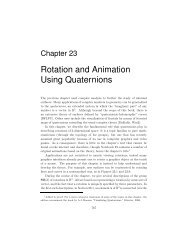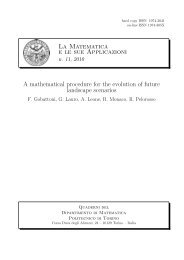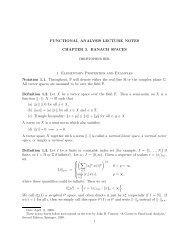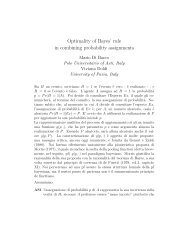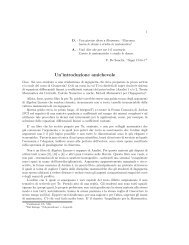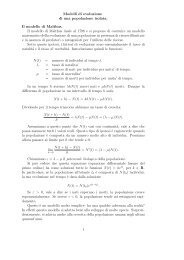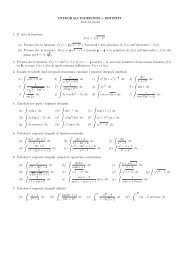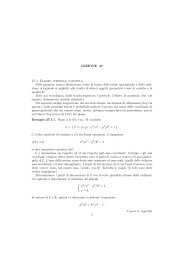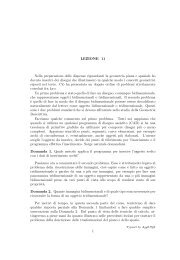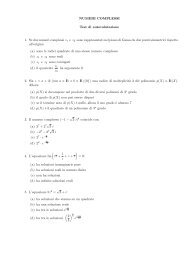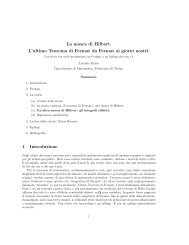EQUAZIONI DIFFERENZIALI Esercizi svolti 1. Determinare la ...
EQUAZIONI DIFFERENZIALI Esercizi svolti 1. Determinare la ...
EQUAZIONI DIFFERENZIALI Esercizi svolti 1. Determinare la ...
You also want an ePaper? Increase the reach of your titles
YUMPU automatically turns print PDFs into web optimized ePapers that Google loves.
<strong>EQUAZIONI</strong> <strong>DIFFERENZIALI</strong><br />
<strong>Esercizi</strong> <strong>svolti</strong><br />
<strong>1.</strong> <strong>Determinare</strong> <strong>la</strong> soluzione dell’equazione differenziale (x 2 + 1)y ′ + y 2 = 0.<br />
2. Risolvere il problema di Cauchy<br />
3. Risolvere il problema di Cauchy<br />
y ′ + x tan y = 0<br />
y(0) = 1<br />
2 π.<br />
y ′ = xy<br />
(x−1) 2<br />
y(2) = <strong>1.</strong><br />
4. <strong>Determinare</strong> a per cui y(x) = xe ax è una soluzione di xy ′′ − xy ′ − y = 0.<br />
5. <strong>Determinare</strong> <strong>la</strong> soluzione generale dell’equazione differenziale (sin x)y ′ + (cos x)y = e x .<br />
6. Risolvere il problema di Cauchy<br />
7. Risolvere il problema di Cauchy<br />
y ′ − y = 1<br />
y(0) = 0.<br />
y ′ = y sin x + sin 2x<br />
y(0) = −2.<br />
8. <strong>Determinare</strong> <strong>la</strong> soluzione generale dell’equazione differenziale y ′ = 1<br />
√ x y + <strong>1.</strong> <strong>Determinare</strong> poi<br />
le soluzioni y(x) che soddisfano lim y(x) = −∞.<br />
x→+∞<br />
9. <strong>Determinare</strong> <strong>la</strong> soluzione di<br />
y ′′ − 2y ′ − 8y = 0<br />
y(1) = 1, y ′ (1) = 0<br />
e il suo valore in x = 0.<br />
10. <strong>Determinare</strong> l’integrale generale dell’equazione differenziale y ′′ − 4y ′ + 13y = x e x .<br />
1<strong>1.</strong> <strong>Determinare</strong> l’integrale generale dell’equazione differenziale y ′′ + y ′ + 1<br />
4 y = cos x.<br />
12. Risolvere il problema di Cauchy<br />
13. Risolvere il problema di Cauchy<br />
y ′′ − 8y ′ + 15y = 2 e 3x<br />
y(0) = 0, y ′ (0) = 0.<br />
y ′′ − y = x e x<br />
y(0) = 0 = y ′ (0).<br />
14. <strong>Determinare</strong> una soluzione partico<strong>la</strong>re dell’equazione differenziale<br />
y ′′ − 4y ′ + 5y = e 2x (1 + cos x) + 5x 2 .
15. Risolvere il problema di Cauchy<br />
16. Risolvere il problema di Cauchy<br />
17. Risolvere il problema di Cauchy<br />
y ′′ − 2y ′ + y = e x<br />
x+2<br />
y(0) = 0, y ′ (0) = 0.<br />
y ′′ + y = 1<br />
cos x<br />
y(0) = 0, y ′ (0) = 0.<br />
y ′′ − 2y ′ = e x<br />
cosh x<br />
y(0) = 0, y ′ (0) = 0.<br />
18. Verificare che sin 2x è una soluzione di y ′′′′ +4y ′′′ +8y ′′ +16y ′ +16y = 0, e trovare <strong>la</strong> soluzione<br />
generale.<br />
19. Risolvere il problema di Cauchy<br />
y ′′′ − y = 0<br />
y(0) = 1, y ′ (0) = 0, y ′′ (0) = 0.
<strong>EQUAZIONI</strong> <strong>DIFFERENZIALI</strong><br />
<strong>Esercizi</strong> <strong>svolti</strong> - SOLUZIONI<br />
<strong>1.</strong> Riscriviamo l’equazione differenziale nel<strong>la</strong> forma<br />
dy y2<br />
= − ,<br />
dx 1 + x2 che è a variabili separabili. La soluzione costante è y(x) = 0 ∀x. Se y non è identicamente<br />
nullo, abbiamo<br />
<br />
dy dx dy dx 1<br />
= − ⇒ = − ⇒ = arctan x + c,<br />
y2 1 + x2 y2 1 + x2 y<br />
da cui<br />
1<br />
y(x) =<br />
arctan x + c ,<br />
dove c ∈ R. (La soluzione costante y(x)=0 corrisponde a c = ±∞).<br />
2. La soluzione costante y = 0 non soddisfa <strong>la</strong> condizione iniziale. Separando le variabili otteniamo<br />
dy<br />
= −x dx<br />
tan y<br />
⇒<br />
<br />
cos y<br />
dy = − x dx<br />
sin y<br />
⇒ ln | sin y| = − 1<br />
2 x2 + a ⇒ | sin y| = e a e −x2 /2<br />
⇒ sin y = ±e a e −x2 /2 = c e −x 2 /2<br />
dove a ∈ R e c = ±e a è una costante non nul<strong>la</strong>. Ponendo <strong>la</strong> condizione iniziale si ottiene<br />
c = <strong>1.</strong> Esplicitando <strong>la</strong> y abbiamo infine <strong>la</strong> soluzione del problema di Cauchy:<br />
y(x) = arcsin(e −x2 /2 ).<br />
3. La nostra equazione differenziale può essere considerata sia a variabili separabili che lineare.<br />
Nel primo caso procedendo con <strong>la</strong> separazione delle variabili otteniamo<br />
<br />
dy<br />
y =<br />
<br />
x<br />
dx.<br />
(x − 1) 2<br />
Il secondo integrale si risolve ponendo x − 1 = t:<br />
<br />
t + 1<br />
1<br />
1<br />
log |y| = dt = log |t| − + c = log |x − 1| − + c.<br />
t2 t x − 1<br />
Esplicitando <strong>la</strong> y otteniamo<br />
|y| = e c e −1/(x−1) 1<br />
−<br />
|x − 1| ⇒ y(x) = k(x − 1) e x−1 ,<br />
dove k = ±e c è una costante non nul<strong>la</strong>. (Abbiamo usato il fatto che |a| = |b| ⇔ a = ±b.)<br />
Imponendo <strong>la</strong> condizione iniziale si ottiene ke −1 = 1, da cui k = e, e infine<br />
1<br />
1−<br />
y(x) = (x − 1) e x−1 = (x − 1)e x−2<br />
x−1 .<br />
4. Si ha y ′ (x) = (1 + ax) e ax , y ′′ (x) = (2a + a 2 x) e ax . Sostituendo nell’equazione si ottiene<br />
x[e ax (a 2 x + 2a)] − x[e ax (ax + 1)] − [x e ax ] = 0 ⇒ (a 2 − a)x 2 + (2a − 2)x = 0.<br />
I coefficienti di x e x 2 devono annul<strong>la</strong>rsi entrambi, quindi a = <strong>1.</strong>
5. Dividendo per sin x (supponendo sin x = 0) otteniamo<br />
y ′ cos x ex<br />
= − y +<br />
sin x sin x ,<br />
che è un’equazione differenziale lineare, cioè del<strong>la</strong> forma y ′ = a(x)y + b(x). Ricordiamo <strong>la</strong><br />
formu<strong>la</strong> risolutiva di tali equazioni<br />
y(x) = e A(x)<br />
<br />
e −A(x) b(x) dx,<br />
dove A(x) è una qualsiasi primitiva di a(x). Nel nostro caso si ha<br />
e quindi<br />
cos x<br />
a(x) = −<br />
sin x<br />
=⇒ A(x) = −<br />
<br />
− log | sin x|<br />
y(x) = e<br />
<br />
= 1<br />
| sin x|<br />
= 1<br />
<br />
sin x<br />
<br />
cos x<br />
dx = − log | sin x|,<br />
sin x<br />
log | sin x| ex<br />
e<br />
sin x dx<br />
| sin x| ex<br />
sin x dx<br />
e x dx = ex + c<br />
sin x<br />
(c ∈ R).<br />
Come dominio del<strong>la</strong> soluzione si può prendere qualsiasi intervallo in cui sin x = 0.<br />
6. L’equazione y ′ = y+1 può essere considerata sia a variabili separabili che lineare. Nel secondo<br />
caso possiamo applicare <strong>la</strong> formu<strong>la</strong> risolutiva del problema di Cauchy<br />
y ′ = a(x)y + b(x)<br />
cioè<br />
y(x0) = y0,<br />
y(x) = e A(x)<br />
y0 +<br />
x<br />
x0<br />
e −A(t) <br />
b(t) dt ,<br />
dove A(x) = x<br />
x0 a(t) dt è <strong>la</strong> primitiva di a(x) che si annul<strong>la</strong> in x = x0 . Nel nostro caso<br />
abbiamo x0 = 0, y0 = 0, a(x) = 1 ⇒ A(x) = x<br />
0 1 dt = x, b(x) = 1, e otteniamo<br />
y(x) = e x<br />
0 + −e −t <br />
x<br />
= e x (1 − e −x ) = e x − <strong>1.</strong><br />
0<br />
Possiamo anche calco<strong>la</strong>re prima <strong>la</strong> soluzione generale dell’equazione lineare y ′ = y + 1 con <strong>la</strong><br />
formu<strong>la</strong> risolutiva vista nell’esercizio precedente, ottenendo y(x) = e x e −x dx = k e x − 1, e<br />
poi imporre <strong>la</strong> condizione iniziale y(0) = 0, da cui k = <strong>1.</strong><br />
Considerando invece l’equazione come a variabili separabili, otteniamo<br />
<br />
dy<br />
y + 1 =<br />
<br />
dx ⇒ log |y + 1| = x + c<br />
⇒ |y + 1| = e c e x ⇒ y + 1 = ±e c e x = k e x<br />
dove k = ±e c è una costante diversa da zero. Imponendo y(0) = 0 otteniamo k = 1 e infine<br />
y(x) = e x − 1, come sopra.
7. Applicando <strong>la</strong> formu<strong>la</strong> risolutiva delle equazioni differenziali lineari con A(x) = sin x dx =<br />
− cos x, otteniamo <strong>la</strong> soluzione generale<br />
<br />
− cos x<br />
y(x) = e<br />
− cos x<br />
= 2e<br />
<br />
e cos x sin(2x) dx<br />
e cos x sin x cos x dx<br />
(cos x = t ⇒ − sin xdx = dt)<br />
<br />
− cos x<br />
= −2e t e t dt<br />
= −2e − cos x te t − e t + c <br />
= −2e − cos x (cos xe cos x − e cos x + c)<br />
= −2 cos x + 2 − 2ce − cos x .<br />
Imponendo y(0) = −2 si ottiene c = e, e infine<br />
y(x) = 2 − 2 cos x − 2e 1−cos x .<br />
8. Si tratta di un’equazione differenziale lineare con a(x) = 1/ √ x ⇒ A(x) = 2 √ x. Applicando<br />
<strong>la</strong> formu<strong>la</strong> risolutiva abbiamo<br />
<br />
y(x) = e 2√ x<br />
e −2√ x dx<br />
(2 √ x = t ⇒ x = 1<br />
<br />
t e −t dt<br />
= 1<br />
2 e2√ x<br />
4t2 , dx = 1<br />
2<br />
= 1<br />
2 e2√ x −te −t − e −t + c <br />
t dt)<br />
= 1<br />
2 e2√ x <br />
−2 √ xe −2√ x − e −2 √ x + c<br />
= − √ x − 1 1<br />
2 + 2c e2√ x<br />
.<br />
Calco<strong>la</strong>ndo il limite di y(x) per x → +∞ si ottiene<br />
<br />
+∞ se c > 0<br />
lim y(x) =<br />
x→+∞ −∞ se c ≤ 0.<br />
Tutte le soluzioni con c ≤ 0 soddisfano dunque lim y(x) = −∞.<br />
x→+∞<br />
9. Il polinomio caratteristico è λ2 − 2λ − 8 = (λ − 4)(λ + 2) e le radici sono 4, −2. La soluzione<br />
generale dell’equazione è perciò c1e4x + c2e−2x (c1, c2 ∈ R), e le condizioni iniziali danno<br />
<br />
c1e4 + c2e−2 = 1<br />
4c1e4 − 2c2e−2 = 0<br />
⇒<br />
<br />
c1 = 1<br />
3e−4 Quindi y(x) = 1<br />
3 e4x−4 + 2<br />
3 e2−2x , e y(0) = 1<br />
3 (e−4 + 2e 2 ).<br />
<br />
c2 = 2<br />
3 e2 .<br />
10. Risolviamo prima l’equazione omogenea y ′′ − 4y ′ + 13y = 0. Il polinomio caratteristico è<br />
p(λ) = λ 2 −4λ+13 e l’equazione caratteristica p(λ) = 0 ha le soluzioni (complesse coniugate)<br />
λ = 2 ± 3i. L’integrale generale dell’omogenea è dunque<br />
yom(x) = c1 e 2x cos(3x) + c2 e 2x sin(3x).
A questo bisogna aggiungere una soluzione partico<strong>la</strong>re qualsiasi dell’equazione non omogenea,<br />
con termine forzante x e x . Poichè x è un polinomio di primo grado e poichè e x non è soluzione<br />
dell’omogenea, cerchiamo una soluzione partico<strong>la</strong>re con il metodo di somiglianza nel<strong>la</strong> forma<br />
yp(x) = (Ax + B)e x . Si ha<br />
y ′ p(x) = (Ax + B + A)e x , y ′′<br />
p(x) = (Ax + 2A + B)e x .<br />
Sostituendo nell’equazione non omogenea si ottiene<br />
e x {Ax + 2A + B − 4Ax − 4B − 4A + 13Ax + 13B} = x e x ,<br />
cioè 10Ax − 2A + 10B = x, da cui<br />
10A = 1<br />
⇒<br />
A = 1/10<br />
−2A + 10B = 0<br />
B = 1/50.<br />
Una soluzione partico<strong>la</strong>re del<strong>la</strong> non omogenea è dunque yp(x) = <br />
1 1<br />
10x + 50 ex , e l’integrale<br />
generale è<br />
y(x) = yom(x) + yp(x) = c1 e 2x cos(3x) + c2 e 2x sin(3x) + <br />
1 1 x<br />
10x + 50 e .<br />
1<strong>1.</strong> Il polinomio caratteristico p(λ) = λ2 +λ+ 1<br />
4<br />
1 = (λ+<br />
<strong>la</strong> soluzione generale dell’equazione omogenea associata è<br />
yom(x) = c1 e −x/2 + c2 x e −x/2 .<br />
2 )2 ha <strong>la</strong> radice doppia λ = − 1<br />
2<br />
. Pertanto<br />
Con il metodo di somiglianza, cerchiamo una soluzione partico<strong>la</strong>re del<strong>la</strong> non omogenea nel<strong>la</strong><br />
forma yp(x) = A cos x+B sin x. Si ha y ′ p(x) = −A sin x+B cos x, y ′′<br />
p(x) = −A cos x−B sin x.<br />
Sostituendo nell’equazione non omogenea si ottiene<br />
−A + B + 1<br />
4 A cos x + −B − A + 1<br />
4 B sin x = cos x.<br />
Questa re<strong>la</strong>zione deve valere per ogni x ∈ R. Otteniamo così il sistema<br />
<strong>la</strong> cui soluzione è A = − 12<br />
25<br />
<br />
3 − 4A + B = 1<br />
−A − 3<br />
4<br />
B = 0,<br />
16 , B = 25 . L’integrale generale è dunque<br />
y(x) = c1 e −x/2 + c2 x e −x/2 − 12<br />
16<br />
25 cos x + 25 sin x.<br />
12. Determiniamo innanzitutto l’integrale generale. Il polinomio caratteristico p(λ) = λ 2 − 8λ +<br />
15 = (λ−3)(λ−5) ha le due radici reali e distinte λ = 3, 5; <strong>la</strong> soluzione generale dell’omogenea<br />
è c1 e 3x + c2 e 5x . L’equazione non omogenea ha termine forzante 2 e 3x . Poichè e 3x è già<br />
soluzione dell’omogenea, cerchiamo una soluzione partico<strong>la</strong>re del<strong>la</strong> non omogenea nel<strong>la</strong> forma<br />
yp(x) = A x e 3x . Si ha<br />
y ′ p(x) = A(3x + 1)e 3x , y ′′<br />
p(x) = A(9x + 6)e 3x .<br />
Sostituendo nell’equazione non omogenea otteniamo<br />
da cui A = −<strong>1.</strong> L’integrale generale è dunque<br />
A [9x + 6 − 8(3x + 1) + 15x] e 3x = 2 e 3x ,<br />
y(x) = c1 e 3x + c2 e 5x − x e 3x .<br />
Calco<strong>la</strong>ndo y ′ (x) e imponendo le condizioni iniziali y(0) = 0 = y ′ (0) otteniamo il sistema<br />
c1 + c2 = 0<br />
3c1 + 5c2 − 1 = 0<br />
La soluzione del problema di Cauchy è infine<br />
⇒<br />
c1 = −1/2<br />
c2 = 1/2.<br />
y(x) = − 1<br />
2 e3x + 1<br />
2 e5x − x e 3x .
13. Il polinomio caratteristico è λ 2 − 1 e quindi l’equazione omogenea ha soluzione generale<br />
c1e x + c2e −x . L’equazione non omogenea ha termine forzante x e x . Poichè x un polinomio di<br />
primo grado e poichè e x è già soluzione dell’omogenea, cerchiamo una soluzione partico<strong>la</strong>re<br />
del<strong>la</strong> non omogenea nel<strong>la</strong> forma yp(x) = (ax + b)x e x . Si ha<br />
y ′ p(x) = [ax 2 + (2a + b)x + b]e x , y ′′<br />
p(x) = [ax 2 + (4a + b)x + 2a + 2b]e x .<br />
Sostituendo nell’equazione non omogenea si ottiene<br />
da cui 4ax + 2a + 2b = x, e quindi<br />
4a = 1<br />
[ax 2 + (4a + b)x + 2a + 2b − ax 2 − bx]e x = x e x ,<br />
2a + 2b = 0<br />
⇒<br />
a = 1/4<br />
b = −1/4.<br />
La soluzione partico<strong>la</strong>re è 1<br />
4 x2ex − 1<br />
4 xex , e l’integrale generale dell’equazione non omogenea<br />
è<br />
y(x) = c1e x + c2e −x + 1<br />
4 x2e x − 1<br />
4 x ex .<br />
Le condizioni iniziali danno origine al sistema<br />
c1 + c2 = 0<br />
c1 − c2 − 1<br />
4 = 0<br />
⇒<br />
c1 = 1/8<br />
c2 = −1/8.<br />
La soluzione del problema di Cauchy è infine<br />
x −x 2 x x<br />
e − e + 2x e − 2x e .<br />
y(x) = 1<br />
8<br />
14. Risolviamo prima l’equazione omogenea L y = 0 dove L y = y ′′ − 4y ′ + 5y . Il polinomio<br />
caratteristico p(λ) = λ 2 − 4λ + 5 ha radici complesse coniugate, λ = (4 ± √ −4)/2 = 2 ± i,<br />
e quindi <strong>la</strong> soluzione generale dell’omogenea è e 2x (c1 sin x + c2 cos x). Per determinare una<br />
soluzione partico<strong>la</strong>re del<strong>la</strong> non omogenea si applica il principio di sovrapposizione: poichè il<br />
termine forzante è <strong>la</strong> somma dei tre termini e 2x , e 2x cos x, 5x 2 , bisogna trovare soluzioni<br />
partico<strong>la</strong>ri per le equazioni L y = e 2x , L y = e 2x cos x e L y = 5x 2 e poi sommarle.<br />
Per l’equazione L y = e 2x si cerca una soluzione nel<strong>la</strong> forma y(x) = a e 2x , non essendo<br />
e 2x soluzione dell’omogenea. Sostituendo nell’equazione L y = e 2x si ottiene facilmente <strong>la</strong><br />
condizione a = 1, e quindi <strong>la</strong> soluzione partico<strong>la</strong>re e 2x .<br />
Siccome e 2x cos x è soluzione dell’omogenea L y = 0, si cerca una soluzione partico<strong>la</strong>re<br />
dell’equazione L y = e2x cos x nel<strong>la</strong> forma y(x) = x e2x (a cos x + b sin x). Sostituendo<br />
nell’equazione L y = e2x cos x si ottiene a = 0 e b = 1<br />
2 , da cui <strong>la</strong> soluzione partico<strong>la</strong>re<br />
1<br />
2x sin x e2x . Invece di riportare i calcoli (che sono abbastanza lunghi), facciamo vedere come<br />
si può giungere al<strong>la</strong> soluzione più velocemente usando il formalismo complesso.<br />
Supponiamo di dover risolvere l’equazione<br />
Ly = P (x) e αx cos βx oppure Ly = P (x) e αx sin βx, (1)<br />
dove P è un polinomio di grado n e L è l’operatore differenziale L = d<br />
dx<br />
2 + a1 d<br />
dx + a2 .<br />
Osserviamo che in generale se Ly1 = f1(x) e Ly2 = f2(x), allora <strong>la</strong> funzione (a valori<br />
complessi) y = y1 + iy2 : R → C soddisfa Ly = f(x) con f = f1 + if2 . Questo segue subito<br />
dal<strong>la</strong> linearità dell’operatore L. Viceversa se y : R → C soddisfa Ly = f(x) con il termine<br />
forzante complesso f = f1 + if2 , allora <strong>la</strong> parte reale y1 = Re y soddisfa Ly1 = f1(x) e <strong>la</strong><br />
parte immaginaria y2 = Im y soddisfa Ly2 = f2(x).
Invece di risolvere le equazioni (1), possiamo allora risolvere l’equazione complessa<br />
Ly = P (x) e (α+iβ)x<br />
e poi prendere <strong>la</strong> parte reale o immaginaria del<strong>la</strong> soluzione trovata. (Si ricordi <strong>la</strong> formu<strong>la</strong> di<br />
Eulero e iβx = cos βx + i sin βx.) Il metodo di somiglianza complesso dice che <strong>la</strong> (2) ha una<br />
soluzione partico<strong>la</strong>re del<strong>la</strong> forma<br />
yp(x) = Q(x) x m e (α+iβ)x , dove m =<br />
<br />
0 se p(α + iβ) = 0,<br />
molteplicità di α + iβ se p(α + iβ) = 0,<br />
p(λ) = λ 2 + a1λ + a2 è il polinomio caratteristico, e Q(x) è un polinomio a coefficienti<br />
complessi di grado n, cioè Q(x) = Q1(x) + iQ2(x) con Q1, Q2 polinomi reali di grado n.<br />
Una volta determinata yp (sostituendo <strong>la</strong> (3) nel<strong>la</strong> (2)) separiamo <strong>la</strong> parte reale e immaginaria<br />
yp(x) = e αx x m [Q1(x) + iQ2(x)] (cos βx + i sin βx)<br />
e vediamo che<br />
= e αx x m {Q1(x) cos βx − Q2(x) sin βx + i [Q2(x) cos βx + Q1(x) sin βx]} ,<br />
y (1)<br />
p (x) = Re yp(x) = e αx x m [Q1(x) cos βx − Q2(x) sin βx] risolve Ly = P (x) e αx cos βx,<br />
mentre<br />
y (2)<br />
p (x) = Im yp(x) = e αx x m [Q2(x) cos βx + Q1(x) sin βx] risolve Ly = P (x) e αx sin βx.<br />
Tornando al nostro caso concreto, invece di risolvere y ′′ − 4y ′ + 5y = e 2x cos x risolviamo<br />
l’equazione complessa<br />
y ′′ − 4y ′ + 5y = e (2+i)x . (4)<br />
Poichè 2 + i è radice di p(λ) con molteplicità 1, cerchiamo una soluzione partico<strong>la</strong>re del<strong>la</strong> (4)<br />
nel<strong>la</strong> forma<br />
yp(x) = A x e (2+i)x<br />
dove A ∈ C è una costante complessa (polinomio complesso di grado zero) da determinare.<br />
Si ha<br />
y ′ p(x) = A e (2+i)x + A x(2 + i)e (2+i)x ,<br />
Sostituendo nel<strong>la</strong> (4) otteniamo l’equazione<br />
y ′′<br />
p(x) = 2A(2 + i)e (2+i)x + A x(2 + i) 2 e (2+i)x .<br />
e (2+i)x A x (2 + i) 2 − 4(2 + i) + 5 + 2A(2 + i) − 4A = e (2+i)x .<br />
Il termine in parentesi quadra si annul<strong>la</strong> essendo uguale a p(2 + i) = 0. Otteniamo 2Ai = 1,<br />
da cui A = 1 i<br />
2i = − 2 , e<br />
yp(x) = − i<br />
2 x e(2+i)x = − i<br />
2 x e2x (cos x + i sin x)<br />
= x e 2x ( 1<br />
2<br />
sin x − i<br />
2<br />
cos x).<br />
Poichè e 2x cos x = Re e (2+i)x , <strong>la</strong> soluzione partico<strong>la</strong>re cercata è precisamente<br />
Re yp(x) = 1<br />
2 x e2x sin x.<br />
Dal<strong>la</strong> discussione precedente segue inoltre che <strong>la</strong> funzione Im yp(x) = − 1<br />
2 x e2x cos x risolve<br />
y ′′ − 4y ′ + 5y = e 2x sin x.<br />
Infine per l’equazione L y = 5x 2 , si cerca una soluzione nel<strong>la</strong> forma y(x) = a + bx + cx 2 .<br />
Sostituendo nell’equazione L y = 5x 2 si ottiene facilmente <strong>la</strong> soluzione partico<strong>la</strong>re<br />
y(x) = 22<br />
25<br />
+ 8<br />
5 x + x2 .<br />
Una soluzione partico<strong>la</strong>re dell’equazione originale è quindi:<br />
y(x) = e 2x + 1<br />
2 x sin x e2x + 22<br />
25<br />
+ 8<br />
5 x + x2 .<br />
(2)<br />
(3)
15. In questo caso il metodo di somiglianza non funziona. Applichiamo allora <strong>la</strong> formu<strong>la</strong> generale<br />
x<br />
y(x) = g(x − t)f(t) dt (5)<br />
che risolve il problema di Cauchy y ′′ + ay ′ + by = f(x)<br />
0<br />
y(0) = 0, y ′ (0) = 0,<br />
dove g è <strong>la</strong> risposta impulsiva, cioè <strong>la</strong> soluzione del problema di Cauchy<br />
y ′′ + ay ′ + by = 0<br />
y(0) = 0, y ′ (0) = <strong>1.</strong><br />
Ricordiamo che <strong>la</strong> risposta impulsiva g(x) è data come segue.<br />
• Se ∆ = a2 − 4b = 0 e λ1, λ2 sono le due radici distinte (reali o complesse coniugate)<br />
del polinomio caratteristico p(λ) = λ2 + aλ + b, si ha<br />
<br />
e λ1x λ2x<br />
− e <br />
.<br />
g(x) = 1<br />
λ1−λ2<br />
Se ∆ < 0 allora λ1,2 = (−a ± i √ −∆)/2, λ1 − λ2 = i √ −∆, e possiamo riscrivere<br />
g(x) come<br />
2 x sin(ωx), dove ω = 1<br />
√<br />
−∆.<br />
g(x) = 1<br />
i √ −∆<br />
a<br />
(−<br />
e 2 +i<br />
√<br />
−∆<br />
)x (− 2 − e a<br />
2 −i<br />
√<br />
−∆<br />
)x 2 <br />
= 1<br />
a<br />
ω<br />
e−<br />
Analogamente se ∆ > 0 si ha λ1,2 = (−a ± √ ∆)/2, λ1 − λ2 = √ ∆, e possiamo<br />
anche scrivere g(x) come<br />
2 x sh (ωx), dove ω = 1<br />
√<br />
∆.<br />
g(x) = 1<br />
√ ∆<br />
a<br />
(−<br />
e 2 +<br />
√<br />
∆<br />
2 )x a<br />
(−<br />
− e 2 −<br />
√<br />
∆<br />
2 )x<br />
= 1<br />
a<br />
ω<br />
e−<br />
• Se ∆ = 0 e λ1 è l’unica radice di p(λ) (con molteplicità 2), si ha<br />
g(x) = x e λ1x = x e − a<br />
2 x .<br />
Nel nostro caso il polinomio caratteristico è p(λ) = λ 2 − 2λ + 1 = (λ − 1) 2 , dunque ∆ = 0,<br />
ed essendo a = −2, <strong>la</strong> risposta impulsiva è<br />
g(x) = x e x .<br />
Il termine forzante f(x) = ex<br />
x+2 è continuo per x > −2 e per x < −2. Poichè le condizioni<br />
iniziali sono poste nel punto x0 = 0, possiamo <strong>la</strong>vorare nell’intervallo x > −2, ottenendo<br />
x<br />
y(x) = (x − t) e<br />
0<br />
x−t et t + 2 dt<br />
= −e x<br />
x<br />
x<br />
t − x<br />
t + 2 − 2 − x<br />
dt = −ex<br />
dt<br />
0 t + 2 0 t + 2<br />
= −e x<br />
x <br />
x + 2<br />
1 − dt<br />
0 t + 2<br />
= −x e x + (x + 2)e x [log |t + 2|] x<br />
0<br />
= −x e x + (x + 2)e x <br />
x + 2<br />
log .<br />
2<br />
Notiamo che essendo yom(x) = c1e x + c2x e x <strong>la</strong> soluzione generale dell’omogenea, possiamo<br />
scrivere l’integrale generale dell’equazione non omogenea y ′′ − 2y ′ + y = ex<br />
x+2 sull’intervallo<br />
(−2, +∞) nel<strong>la</strong> forma<br />
ygen(x) = c1e x + c2x e x + (x + 2)e x log(x + 2).<br />
Infatti il termine −x e x − (x + 2)e x log 2 nel<strong>la</strong> soluzione partico<strong>la</strong>re trovata sopra può essere<br />
inglobato in yom(x).<br />
2<br />
2
16. Si ha p(λ) = λ 2 + 1, dunque ∆ = −4 < 0, ω = √ −∆/2 = 1, ed essendo a = 0 otteniamo <strong>la</strong><br />
risposta impulsiva<br />
g(x) = 1<br />
ω e−ax/2 sin(ωx) = sin x.<br />
I dati iniziali sono posti nel punto x0 = 0 e possiamo <strong>la</strong>vorare nell’intervallo (−π/2, π/2),<br />
dove il termine forzante f(x) = 1/ cos x è continuo. Applicando <strong>la</strong> formu<strong>la</strong> (5) otteniamo<br />
x<br />
y(x) = sin(x − t)<br />
0<br />
1<br />
cos t dt<br />
x<br />
= (sin x cos t − cos x sin t)<br />
0<br />
1<br />
cos t dt<br />
x x sin t<br />
= sin x dt − cos x<br />
cos t dt<br />
0<br />
= x sin x + cos x [log | cos t|] x<br />
0<br />
= x sin x + cos x log(cos x).<br />
17. Si ha p(λ) = λ 2 − 2λ = λ(λ − 2) quindi ∆ = 4 > 0, ω = √ ∆/2 = 1, ed essendo a = −2<br />
otteniamo <strong>la</strong> risposta impulsiva<br />
g(x) = 1<br />
ω e−ax/2 sh(ωx) = e x sh x.<br />
Il termine forzante f(x) = ex<br />
è continuo su tutto R, e dal<strong>la</strong> (5) otteniamo<br />
ch x<br />
x<br />
y(x) = e<br />
0<br />
x−t sh(x − t) et<br />
ch t dt<br />
= e x<br />
x<br />
(sh x ch t − ch x sh t)<br />
0<br />
1<br />
ch t dt<br />
= e x x<br />
sh x dt − e x x sh t<br />
ch x<br />
ch t dt<br />
0<br />
= x e x sh x − e x ch x [log(ch t)] x<br />
0<br />
= x e x sh x − e x ch x log(ch x).<br />
18. Invece di fare una verifica diretta, calcoliamo il polinomio caratteristico,<br />
p(λ) = λ 4 + 4λ 3 + 8λ 2 + 16λ + 16,<br />
e ricordiamo che sin 2x è una soluzione se e solo se 2i e −2i sono radici di p(λ). In effetti si<br />
ha p(2i) = 2 4 − 4i 2 3 − 8 2 2 + 16i 2 + 16 = 0, e p(−2i) è anch’esso zero. (Non c’è bisogno di<br />
verificarlo: poichè p(λ) ha coefficienti reali, se λ0 è una radice, anche il complesso coniugato<br />
λ0 è una radice.) Quindi sin 2x è una soluzione, e un’altra soluzione indipendente è cos 2x.<br />
Per determinare altre 2 soluzioni indipendenti, dobbiamo trovare tutte le radici di p(λ).<br />
Sappiamo che p(λ) è divisibile per (λ − 2i)(λ + 2i) = λ 2 + 4. Dividendo p(λ) per λ 2 + 4<br />
otteniamo<br />
p(λ) = (λ 2 + 4)(λ 2 + 4λ + 4) = (λ 2 + 4)(λ + 2) 2 .<br />
Dunque λ = −2 è una radice doppia di p(λ). La soluzione generale è quindi<br />
y(x) = c1e −2x + c2x e −2x + c3 sin 2x + c4 cos 2x.<br />
0<br />
0
19. Consideriamo l’equazione differenziale y ′′′ − y = 0. Le soluzioni dell’equazione caratteristica<br />
sono le 3 radici cubiche dell’unità:<br />
p(λ) = λ 3 − 1 = 0<br />
α0 = 1, α1 = e 2πi/3 = − 1<br />
√<br />
3<br />
2 + i 2 , α2 = e 4πi/3 = − 1<br />
√<br />
3<br />
2 − i 2 .<br />
È comodo utilizzare l’integrale generale complesso dell’equazione y ′′′ − y = 0, dato da<br />
y(x) = c0e α0x + c1e α1x + c2e α2x ,<br />
dove c0, c1, c2 ∈ C. Imponendo le condizioni iniziali y(0) = 1, y ′ (0) = 0, y ′′ otteniamo il sistema<br />
⎧<br />
⎪⎨ c0 + c1 + c2 = 1<br />
(0) = 0,<br />
c0 + α1c1 + α2c2 = 0<br />
⎪⎩<br />
(6)<br />
c0 + α 2 1 c1 + α 2 2 c2 = 0,<br />
<strong>la</strong> cui soluzione è c0 = c1 = c2 = 1<br />
3 , come si verifica subito. (Si noti che α0 + α1 + α2 = 0, e<br />
che α 2 1 = α2 , α 2 2 = α1 .) Otteniamo infine<br />
y(x) = 1<br />
= 1<br />
= 1<br />
3ex + 1<br />
3<br />
3ex + 1<br />
x<br />
3e− 2<br />
3ex + 2<br />
3<br />
1<br />
e(− 2 +i<br />
√<br />
3<br />
2 )x + 1<br />
3<br />
<br />
e i<br />
√<br />
3<br />
2 x + e −i<br />
e− x<br />
2 cos<br />
√ 3<br />
2 x<br />
<br />
.<br />
1<br />
e(− 2 −i<br />
√<br />
3<br />
2 )x<br />
√ 3<br />
2 x



